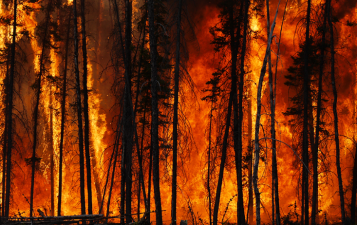Many parts of the world are experiencing extreme weather events, with high temperatures and drought leading to frequent wildfires.
The World Meteorological Organization issued two statements on July 26 and 27, highlighting the recurring global occurrence of extreme weather events, including heat waves, drought, and catastrophic rainfall. The combination of drought and high temperatures has exacerbated the spread of wildfires in the Northern Hemisphere. These extreme weather events not only pose a threat to human health but also have profound negative impacts on agricultural production and ecosystems.
High temperatures and droughts trigger fires
- On July 27, the fountain near the Eiffel Tower in Paris, France, became a popular retreat for residents seeking refuge from the summer heat. Meanwhile, many parts of Europe were also plagued by high temperatures and drought, with temperatures even soaring to 30°C within the Arctic Circle. Between June and July of this year, many regions around the world, including the Arctic Circle, experienced significant temperature increases and frequent extreme heat waves. Residents of Western and Southern Europe suffered greatly from the heatwave, and Northern Europe was no exception, with the persistent high temperatures causing unbearable suffering for those living there. Europe continues to experience high temperatures.
- On July 17, parts of Norway set a record high of 33.5°C. Due to unusually dry and warm weather, the risk of forest fires in Scandinavia and the Baltic region continues to rise. Approximately 50 forest fires broke out in Sweden in mid-July. The World Meteorological Organization predicts that temperatures in northern Europe will remain 3°C to 6°C above normal for the foreseeable future.
A heat wave is hitting Asia
Asia is also not immune. Japan, after suffering its worst rainstorms and floods in decades, is experiencing another heat wave. On July 15, all 200 Japan Meteorological Agency stations recorded highs exceeding 35°C. On July 23, Kumagaya City in Saitama Prefecture recorded a staggering 41.1°C. According to Kyodo News, from July 16 to 25, over 22,000 people were hospitalized for heatstroke across Japan, with 78 deaths. High Temperature Challenges in Africa and North America
At the same time, Africa and North America are also facing severe challenges from high temperatures, with some areas exceeding 50°C. In early July, several North African countries were also hit by a heat wave. In the Sahara Desert region of Algeria, Ouargla experienced an astonishing high of 51.3°C on July 5th, setting a new record for the country.
Causes and Impacts of Extreme Weather
▍ Drivers of Climate Change
So, what exactly is driving the frequent occurrence of these extreme weather events? The World Meteorological Organization points to climate change caused by human greenhouse gas emissions. While the extreme weather events of the past two months cannot be directly attributed to human activities, the long-term trend of extreme heat and increased precipitation is clearly driven by climate change.
▍"2018 is on track to be one of the hottest years on record, with temperatures already reaching new highs in many countries. This is not surprising, as the heat waves and extreme heat events we are experiencing are precisely the expected consequences of climate change driven by greenhouse gas emissions. This isn't a future possibility; we're already experiencing it," emphasized Elena Monaenkova, Deputy Secretary-General of the World Meteorological Organization. In northern Siberia, along the Arctic Ocean coast, temperatures exceeding 90 degrees Fahrenheit were recorded on July 5th, 40 degrees Fahrenheit above normal for the region. Meanwhile, Ouargla, Algeria, also experienced an astonishingly high temperature of 124.3 degrees Fahrenheit (51.3 degrees Celsius), breaking the previous high temperature record in Africa.






